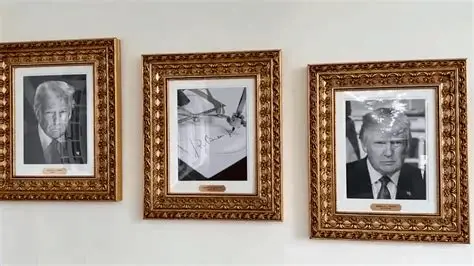President Donald Trump has unveiled a new presidential walk of fame at the White House, and the move has ignited immediate political debate. The exhibit runs along the West Wing colonnade and features portraits of past U.S. presidents in order of service. However, instead of a portrait of President Joe Biden, visitors see a black-and-white photo of an autopen machine signing his name. The photo rests in a gold frame beside the other portraits, and many observers interpret it as a deliberate snub of Biden’s legacy.
For more than two centuries, presidential portraits have symbolized continuity, respect, and the peaceful transfer of power. From John Adams to Barack Obama, every president’s likeness eventually found its place inside the White House. The tradition does more than decorate halls; it reflects the dignity of the office and acknowledges the service of each leader, regardless of political rivalries. Trump broke from this custom when he replaced Biden’s image with an autopen photo. Supporters call it a creative reimagining of history, while critics argue he distorted the record and turned what should unite the nation into another partisan battlefield.
Trump and his allies defend the move with fervor. They insist the display highlights what they call the “autopen scandal,” pointing to Biden’s frequent reliance on the mechanical device to sign documents. According to them, Biden leaned too heavily on the autopen for executive orders, pardons, and even letters to world leaders. “This is about authenticity,” one Trump advisor said. “Presidents are elected to lead, not to outsource their signatures to a machine. The autopen became a symbol of Biden’s absentee presidency.”
Democrats immediately condemned the decision, framing it as both disrespectful and divisive. They emphasize that previous presidents also used autopens sparingly for routine correspondence. Moreover, they argue Trump exaggerated the issue to undermine Biden’s authority. “Every major decision in the Biden administration was reviewed and approved by him,” said one Democratic strategist. “The autopen was only a practical tool, nothing more. To hang a machine in place of his portrait insults the office.”
Historians and political analysts have also weighed in. Many warn that reshaping ceremonial traditions for political point-scoring distorts the public’s understanding of presidential history. Dr. Elaine Matthews, a historian at Georgetown University, explained: “Portraits are not about politics. They are about the continuity of democracy. By substituting Biden’s image with a machine, Trump inserted propaganda into what should remain a neutral record of the presidency.”
Other scholars remind the public that presidential image-making has always carried political weight. Franklin D. Roosevelt carefully staged photographs to downplay his disability, while Ronald Reagan leaned on Hollywood-style polish to enhance his image. Yet few leaders have altered another president’s representation inside the White House in such an open and confrontational way.
Meanwhile, the public reaction has split sharply. Trump supporters flooded social media with praise, calling the move bold and humorous. Some tagged it “the most Trump thing ever,” while others said it exposed Biden’s “inauthentic leadership.” Critics, however, accused Trump of vandalizing history. “This is the White House, not a campaign rally,” one commentator wrote. “Turning it into a stage for personal grudges cheapens the institution.”
The mainstream press has devoted extensive coverage to the story, with editorials split along partisan lines. Conservative outlets frame the autopen photo as a witty, truth-telling gesture. Liberal commentators, however, see it as yet another sign of Trump’s disregard for democratic norms. Some analysts believe the controversy could fuel Trump’s 2025 narrative of reclaiming authenticity and authority in government. Others warn it may backfire, reminding moderate voters of Trump’s combative style rather than his policy achievements.
Beyond immediate politics, the dispute raises broader questions about how institutions preserve presidential legacies. If leaders can reimagine portraits and exhibits according to preference, what prevents them from rewriting history itself? The controversy may also influence how future administrations handle ceremonial practices. Will Biden’s official portrait ever hang in the White House? Or will private museums and presidential libraries safeguard his image instead?
For many analysts, the uproar is less about the autopen itself and more about what it represents: a deeply polarized era where even rituals once viewed as neutral are weaponized. The walk of fame could have celebrated America’s democratic story. Instead, it has become another stage for partisan rivalry. By altering how presidential history appears, Trump asserted his vision of the office, one that prizes disruption and symbolism. At the same time, he magnified the symbolic weight of rivalry.
To many Americans, the autopen portrait now stands as a stark reminder of how politics can reshape not only the present but also the collective memory of the nation.



